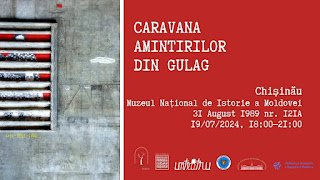  Events Archive Events Archive
Itinerant exhibition “Caravan of memories from the Gulag”, at the National Museum of History of Moldova
July 19, 2024
On July 19, in the courtyard of the National Museum of History of Moldova, the Opening of the traveling exhibition "Caravan of memories from the Gulag" took place, which passed through several towns in Romania and the Republic of Moldova in order to talk to the larger public about the history and memory of the victims of the totalitarian-communist regime from the left of the Prut. The exhibition was organized by the National Museum of History of Moldova in partnership with the Association for Culture and Arts Arbor, originating from the exhibition "Remembering childhood: testimonies of Bessarabian deportees", opened as part of this cooperation in 2022, at Arbor.art.room in București. The exhibition is based on the research component and is elaborated from a curatorial and interdisciplinary perspective, by building an installation with the testimonies of the deportees, with photographs, graphics, artworks, audio and video materials. Thus, for a better understanding of the redeployment of deportees to the "special settlements" and the trauma experienced on foreign land, the "Caravan of memories from the Gulag" presented oral history testimonies and photographic artefacts from the thematic heritage of the National Museum of History of Moldova, and among the special exhibits was the map of Bessarabians in the Gulag (2022) by Ramona Iacob, the animation Mîța fără nume (2022) by Ghenadie Popescu, the artworks Familia Pascal and Mother's shawl (2024) by Vasile Rață. The "Caravan of memories from the Gulag" traveled between July 9-19, 2024, starting from București to Chișinău and making an exhibition stop in the evening, between 5:00 p.m. and 9:00 p.m., in Focșani, Iași, Nisporeni, Plop (Dondușeni district), Drochia, Hâncești, Căușeni, Cahul, and Avdarma (ATU Gagauzia). The head of the branch Museum of Victims of Deportations and Political Repressions, assoc. prof. dr. Ludmila Cojocaru, mentioned that "such itinerant exhibitions bring the memory of both banks of the Prut closer together and contribute, through concrete actions, to the building of a European commemorative culture in the Republic of Moldova". The project manager of the "Caravan of Memories from the Gulag", Ms. Victoria Nagy Vajda, said that the project was initiated in 2022, its trigger being Russia's war of aggression against Ukraine. "I wanted to create an itinerary of several testimonies of different people from the moment they got up, the moment they went on the train, the impressions they had, the situation they were in at that moment, the moment they arrived, the jobs they were doing family members, especially parents or brothers, older sisters, the relationships they had with the school, and finally we have a testimony of Stalin's death and what this event meant to them." In the context of a lasting war on the borders of the Republic of Moldova and Romania, that of the Russian Federation against Ukraine, the realization of the traveling exhibition "Caravan of memories from the Gulag" is necessary both for the historical knowledge on the Soviet occupation and for keeping alive the memory of the atrocities that happened then, for not to forget about the danger of totalitarianisms, in all times.
|





 The side panels are elegantly decorated with refined cast-iron elements in the Art Nouveau style, displaying the brand name - "Ideal." The Polyglott model, featuring a bilingual keyboard patented in the United Kingdom by Max Klaczko from Riga, Latvia, was produced between 1902 and 1913, marking the first typewriter capable of writing in two languages. The "Ideal Polyglott" typewriter was actively sold in the Russian Empire and gained significant popularity in Poland, Bulgaria, and Serbia.
The side panels are elegantly decorated with refined cast-iron elements in the Art Nouveau style, displaying the brand name - "Ideal." The Polyglott model, featuring a bilingual keyboard patented in the United Kingdom by Max Klaczko from Riga, Latvia, was produced between 1902 and 1913, marking the first typewriter capable of writing in two languages. The "Ideal Polyglott" typewriter was actively sold in the Russian Empire and gained significant popularity in Poland, Bulgaria, and Serbia.























































